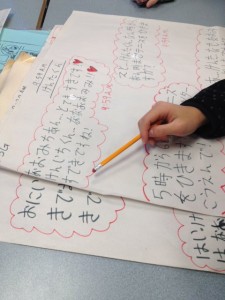 We all get students to write things. We all take the time to read things. But how much to we tap the benefit of students reading each other’s work? Especially when we are trying to hit a targeted structure/vocabulary and have them see it over and over. I have gradually been including more and more of the ‘we read/we look/we ‘evaluate’ opportunities. I use it with written ‘messages’, infographics they make, pamphlets and other student produced text.
We all get students to write things. We all take the time to read things. But how much to we tap the benefit of students reading each other’s work? Especially when we are trying to hit a targeted structure/vocabulary and have them see it over and over. I have gradually been including more and more of the ‘we read/we look/we ‘evaluate’ opportunities. I use it with written ‘messages’, infographics they make, pamphlets and other student produced text.
The Set-Up: Here is the example from my Yr2 class. The targeted structure is ‘want to do/don’t want to do’ and “want/don’t want’. To start the students read a text message between a recurring character and his on again/off again sweetheart. They loved it. I quickly abandoned the boring ‘game’ I had for practicing the structure. Instead I asked them (in partners) to create a text message between two characters of their own. But I hadn’t prepped the assignment. Again I turned to them. I asked them what I would want to see in the piece. They generated a better list of ‘elements’ than I could. Then they set to work. They were so into it and so involved in their message that I gave them 2 periods on it. Some wrote on paper, a couple did text message screen shots – every group decided on ‘how’ they would produce this (we are NOT a high-tech school). New words are allowed (up to 5) as long as a glossary is provided for the readers.
Reading Day: We set out what is to be read on top of the desks. I ask the students to step out of the room for instructions (because in my space I can). I ask them to move from piece to piece with their partner and to read thoroughly. This is NOT a race to read all. Quality reading is expected. I find that pulling them out and then sending them back in ‘sets the stage’ for the type of activity that I want and focuses them on their in-room activity a little more than just giving instructions in the classroom. Then they enter the room and begin.
Students move from table to table with their partner. They record their names on a post-it on the table to note that they have been there. In this case it was a text message so they each read a ‘part’. If it isn’t a message then they take turns reading the text and talking about what they are reading.
They have about 45 minutes for the reading. They move from place to place as they open up. I don’t specify how long they have to read – they take the time they need. For some readings I expect them to read them all (infographics etc). For others – with more detailed text I don’t. So sometimes they go to all of the tables, sometimes they don’t finish.
The Post-Read Activity: The KEY for me in this is the post-reading task which requires them to evaluate/use the content. This means that they have to comprehend what they are doing. For the Yr2’s I asked them to read for the required content “We saw…” and then to give their impression of the overall piece. This is quite ‘target structure’ specific but for this – it was my goal. Each team is asked to read 4 pieces in this way. (The sheet they got for this is here). For my higher grades I ask them to do things like choose something to fit a category and use the information on it to defend their choice (in the TL or English). A link to this style of post reading (from the Sumo Cultural Activity) is here. Generally the reading/post-reading happens in 1 (80 min) period although asking them to read for specific targeted content in text-heavy pieces may take longer.
My students like the class because they move/work freely with their partner. One Yr2 told me that “It’s fun and interactive – I like reading all the messages and its great because I understand what I am reading!”. I like it because they see the same structures over and over and, best of all, are creating with the language that they are learning.
Colleen


4 Comments
Leave a reply →